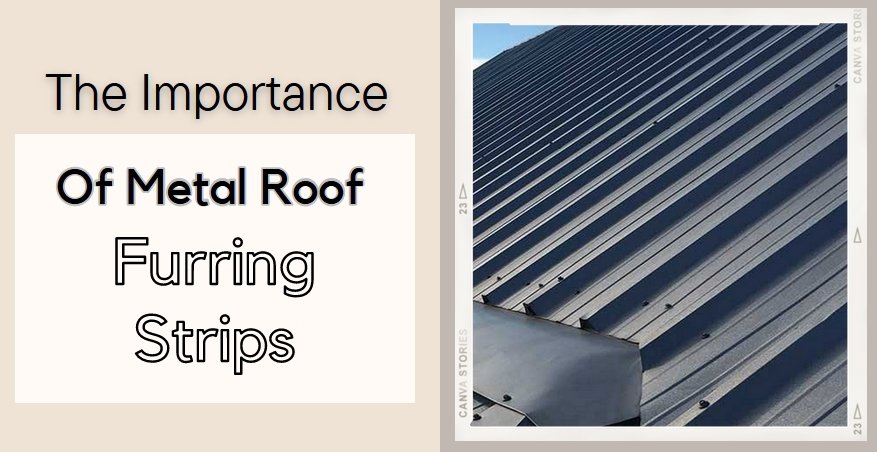When considering a sturdy roof, we often visualize the external materials, colors, and designs. However, beneath those metal sheets lies a pivotal component in the roof’s longevity and efficiency: the furring strips on the roof.
Though hidden from view, these strips ensure our roofs remain durable, insulated, and resistant to the outer elements. As homeowners, it’s essential to recognize and understand the significance of these furring strips.
What Purpose Do Metal Roof Furring Strips Serve in Roofing?
Furring strips, often made of wood or metal, are strategically placed beneath metal roofing panels. Their primary functions include:
● Foundational Support Structure
At their core, these strips serve as a foundational support structure. They provide a stable base for the metal panels, ensuring they remain firmly in place, especially during extreme weather conditions.
In my experience of overseeing several roof installations, furring strips were indispensable in creating a level and consistent foundation, significantly reducing the risk of panels becoming dislodged during heavy storms or high winds.

● Insulation Enhancement
They act as a barrier, reducing heat transfer between the metal roof and the underlying roof deck. It can significantly boost your home’s energy efficiency, especially in regions with extreme temperatures. In one case, an installation on a home in a scorching region demonstrated that properly spaced furring strips reduced cooling costs by up to 15% annually.
● Ventilation Improvement
Proper airflow is essential to prevent moisture accumulation beneath the metal sheets. Accumulated moisture can lead to mold growth, structural damage, and a reduction in the roof’s lifespan. By promoting better ventilation, furring strips help minimize these risks, ensuring the space beneath the metal remains dry and free from potential damage.
A professional roofer noted on a forum that skipping furring strips could lead to hidden moisture build-up, which could result in mold and wood rot and compromise the entire roof structure.
● Noise Reduction
Noise reduction is an added advantage. Metal roofs, especially during rain, can amplify sounds, creating a noisy indoor environment. Furring strips help dampen this noise, offering homeowners a quieter and more peaceful living space.
Read also: How long does a Metal Roof Last?
● Leveling Uneven Surfaces
Lastly, furring strips can level out the surface for homes with older roofing systems or those that have experienced minor damage. It ensures that the metal roof is installed on a flat and even base, which is crucial for its longevity and performance.
Why Are Furring Strips Beneath Metal Roofs?
The placement of furring strips beneath metal roofs is not just a customary practice but a necessity for several reasons:
● Durability
As robust as it is, metal can be susceptible to buckling under extreme temperatures. Furring strips provide the necessary foundational support, ensuring the roof remains intact during temperature fluctuations, from scorching summers to freezing winters.
● Protection Against Leaks
Without these strips, metal roofs are more vulnerable to developing leaks. This vulnerability can be attributed to the metal’s tendency to expand and contract with temperature changes. For instance, during a project in a coastal area, where temperature shifts were frequent, furring strips significantly minimized leak incidents and maintained roof integrity.
● Condensation Prevention
Without proper spacing provided by furring strips, there’s a heightened risk of condensation buildup. This moisture accumulation can lead to mold growth, structural damage, and a compromised roofing system.
● Enhanced Roof Lifespan
A well-installed metal roof supported by furring strips can protect homes against storms and adverse weather, extending the roof’s lifespan.
What Determines the Gap Between Furring Strips on a Metal Roof?
The spacing between furring strips is pivotal for the roof’s overall performance. Several factors influence this spacing:
● Roof Type
Different metal roof types require specific spacing of furring strips to ensure optimal performance. For example, practical guidelines recommend that corrugated metal roofing can have furring strips spaced up to 24 inches apart.
In contrast, for standing seam metal roofing, closer spacing, typically around 18 inches, provides better support and prevents metal deformation.
● Roof Slope
The inclination of your roof also dictates the spacing. A low-sloped roof (with a pitch of 2/12 or less) might need strips spaced up to 16 inches apart. In contrast, a steeper slope can accommodate spacings up to 24 inches apart.
● Existing Roofing
If installing over shingles, furring strips are imperative to prevent moisture issues and ensure the metal panels don’t conform to the shape of the underlying shingles over time.
A contractor shared their experience where the lack of furring strips led to direct contact between the metal and shingles, causing premature wear and creating pathways for moisture ingress.
Adhere to the building code guidelines specific to your area to ensure compliance and optimal performance of metal roofing installations.
| Key Function of Furring Strips | Real-Life Application | Benefits Observed |
|---|---|---|
| Foundational Support Structure | Ensures panels remain stable during high winds and heavy storms. | Reduced risk of panel dislodgement and damage. |
| Insulation Enhancement | Installed in hot regions to prevent heat transfer. | Up to 15% reduction in cooling costs annually. |
| Ventilation Improvement | Prevents hidden moisture build-up under the metal. | Avoids mold growth and wood rot. |
| Protection Against Leaks | Used in areas with frequent temperature shifts. | Minimizes leaks and maintains roof integrity. |
| Roofing Over Existing Shingles | Avoids direct contact between metal and shingles. | Prevents premature wear and moisture ingress. |
Metal roof furring strips are integral to the roof’s structure and functionality. Homeowners can enjoy a durable, efficient, and long-lasting roofing system by understanding their role and ensuring proper installation.


